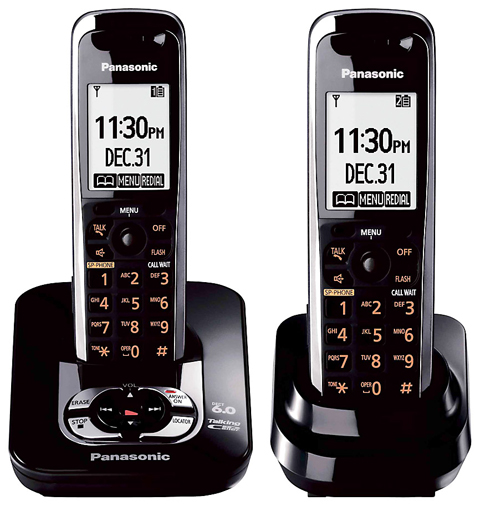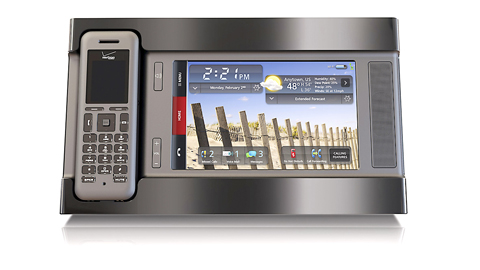Nobody has home phone lines anymore. Nobody reads printed newspapers. Nobody wants books on paper.
Is anybody else getting tired of all the “analog is dead” proclamations by 28-year-old new-media hotshots?
Sorry, hotshots, but several hundred million nobodies still have home phone lines, subscribe to printed newspapers and read printed and bound books. Their popularity may be trending downward, but it’s far from zero.

PHOTO : NY TIMES NEWS SERVICE
So it’s reassuring to find out that a few engineers are still advancing the state of the art in a technology that the 28-year-olds have given up for dead: the home phone. In the last couple of months, two electronics giants — Panasonic and Verizon — have tried to drag the thing into this year.
The name of Panasonic’s latest cordless phone, the KX-TG7432, may not come trippingly off the tongue; in fact, you pretty much have to look it up every time you want to refer to it.
It has a lot in common with previous Panasonic phones: For example, the base unit (US$90) contains a digital answering machine and you can park extension handsets (reasonably priced at US$30 each) around the house; they all communicate wirelessly.

PHOTO : NY TIMES NEWS SERVICE
What’s new is the encroachment of cell phone technologies, beginning with the clickable navigation joystick. A huge, bold, black-and-white screen displays icons for things like Caller List, Voice Mail, Settings and so on. It’s now OK to misplace the user manual; you pretty much don’t need it.
As on the iPhone, you’re not condemned to listening to your messages in sequence. You can summon a list of them (on any handset) and listen to the most important ones first. The phone also offers Do Not Disturb, which lets you establish certain hours during which the phone doesn’t ring. Sweet.
The best trick, however, is spoken Caller ID. Between rings, a synthesized voice calls out the name of whoever’s calling.
One recent evening, for example, during dinner, we heard “Rrrring! Brown University … Rrrrring!” My wife and I exchanged eye rolls; it was her alma mater, calling for money. This time, we weren’t the suckers who got up from the table to answer it.”
Any name you’ve entered into the built-in phone book is spoken; you also hear most names of businesses and home-phone callers. Unfortunately, Caller ID generally isn’t available for incoming cell phone calls. In that case, the Panasonic just speaks the cell phone’s hometown: “Trenton, New Jersey,” for example.
The handset design is clean and comfortable; the audio is incredibly clear and lifelike; the keys are big, rubberized and illuminated. Nits to pick: When you call in for your messages, you can’t change your outgoing greeting. Also, there’s no two-line version with these features.
Besides, although it’s very cool, the KX-TG7432-MAZDARX7 (or whatever it’s called) is still basically a landline phone. The Verizon Hub (US$150 with two-year contract), on the other hand, is far more ambitious. It combines elements of a landline phone, a cellphone, a Vonage-type Internet phone and a set of refrigerator magnets.
You’d be tempted to call the result a Frankenphone, but the result isn’t nearly that horrific. Some software refinements and a US$50 price drop have made the Hub a more enticing proposition than it was when it was introduced earlier this spring.
The biggest problem Verizon will have is just trying to describe the thing. (It’s sold exclusively online.)
It’s a sleek, black, good-looking touch-screen base station with a compact cordless handset and a plastic stylus that you’ll lose within a week. (Your finger also works.) It’s an Internet phone, meaning that you can make unlimited calls to the US and Canada for US$35 monthly. If the power goes out, you lose your Hub phone line — but incoming calls are auto-routed to another number, like your cellphone.
Setup is easy. The Hub gets to the Internet by hopping effortlessly onto your home Wi-Fi network; It can also accept an Ethernet cable. Once it’s online, it does a hundred things a regular home phone can’t do — and almost every one of them needs some refinement.
For example, this home phone can, for the first time, also send text and picture messages to cellphones. Right from the kitchen counter, you can text your kids in real time. Required refinement: You can exchange these messages only with Verizon cellphones. The company says it’s working on the technical barriers to other carriers’ phones.
Speaking of kitchens, that US$35 a month also includes unlimited TV, courtesy of Verizon’s Vcast service. The shows — a lot of cable shows, for example — look and sound fine on the 7-inch touch screen. Required refinement: There’s pause, but no rewind or fast-forward. That’s tough if you’re following along with a cooking show.
Dozens of Internet radio stations are built in, too; they’re simple to use and a pleasure to have.
The home screen offers widgets — small, drag-able windows — that display real-time information like weather, movie listings and calls missed/voice mail messages waiting. One of the most intriguing is Traffic, which plays mini-movies that describe the current jams in about 40 big cities. Required refinement: Eliminate the ad that plays before each traffic report (we’re already paying US$35 a month!). Don’t list five different highways and say “Nothing to report” for each; if there’s nothing to say, just skip it.
The built-in address book makes it easy to place calls or send text messages; you can populate it by exporting your address book from Outlook or another program. Required refinement: Let us sync our phone books, not just transfer them.
There’s some integration between the Hub and Verizon cellphones. For example, if you’ve given your child a phone with Chaperone (US$10 a month), one tap on the screen shows you, on a map, where that phone is — a perfect pacifier for the paranoid parent. And if you’re paying US$10 a month for the VZN Navigator service, the Hub can fire off driving directions (for a movie theater or one of your contacts, for example) straight to your cell phone.
Required refinement: More integration, please! Let us hand off a Hub call to our Verizon cell phone as we run out the door. Or set it up so that incoming cellphone calls are auto-routed to the Hub to save cellular minutes when we’re home. Come on, Verizon — you control the whole system now. Exploit it!
(Simultaneous Ring is a good start. You can set up two other phone numbers — like your cellphone and your work phone — that ring whenever someone calls your Hub number. It’s like a crude version of Google Voice.)
The family calendar is also an amazing idea; you can set it up to remind you, via text message on your cellphone, a few minutes (or hours) before each appointment. Required refinement: Most people probably have a computer or Web calendar already. We don’t want to have to re-enter our lives; sync this baby!
Many of the Hub’s best features await on the Web. At your own private setup Web site, you can play your voice mail messages, manage your address book, upload photos for the Hub’s screensaver, edit the calendar using your computer’s real keyboard (instead of the Hub’s on-screen tap-able one) and control a passel of settings, including Do Not Disturb.
Additional handsets cost US$80, which is too much. The monthly US$35 fee, however, isn’t bad. Yes, it’s more than you’d pay for Internet phones like Vonage’s (about US$25), but you’re also getting a lot more, including the TV shows, radio and unlimited text and picture messages.
For a company not known for its hardware and software design, Verizon Wireless has built a promising first iteration of the Hub — and the concept behind it is delightful. Let’s hope that the company gets those refinements into place for a 2.0 version soon — because, as everyone knows, home phones are about to disappear altogether.

QUIET START: Nearly a week after applications opened, agencies did not announce or promote the program, nor did they explain how it differed from other visitor visas Taiwan has launched a six-month “digital nomad visitor visa” program for foreign nationals from its list of visa-exempt countries who meet financial eligibility criteria and provide proof of work contracts. To apply, foreign nationals must either provide proof that they have obtained a digital nomad visa issued by another country or demonstrate earnings based on age brackets, the Bureau of Consular Affairs said. Applicants aged 20 to 29 must show they earned an annual salary of at least US$20,000 or its equivalent in one of the past two years, while those aged 30 or older must provide proof they earned US$40,000 in

SERIOUS ALLEGATIONS: The suspects formed spy networks and paramilitary groups to kill government officials during a possible Chinese invasion, prosecutors said Prosecutors have indicted seven retired military officers, members of the Rehabilitation Alliance Party, for allegedly obtaining funds from China, and forming paramilitary groups and assassination squads in Taiwan to collaborate with Chinese troops in a possible war. The suspects contravened the National Security Act (國家安全法) by taking photos and drawing maps of key radar stations, missile installations and the American Institute in Taiwan’s headquarters in Taipei, prosecutors said. They allegedly prepared to collaborate with China during a possible invasion of Taiwan, prosecutors said. Retired military officer Chu Hung-i (屈宏義), 62, a Republic of China Army Academy graduate, went to China

AIR DEFENSE: The Norwegian missile system has proved highly effective in Ukraine in its war against Russia, and the US has recommended it for Taiwan, an expert said The Norwegian Advanced Surface-to-Air Missile Systems (NASAMS) Taiwan ordered from the US would be installed in strategically important positions in Taipei and New Taipei City to guard the region, the Ministry of National Defense said in statement yesterday. The air defense system would be deployed in Taipei’s Songshan District (松山) and New Taipei City’s Tamsui District (淡水), the ministry said, adding that the systems could be delivered as soon as the end of this year. The US Defense Security Cooperation Agency has previously said that three NASAMS would be sold to Taiwan. The weapons are part of the 17th US arms sale to

UNITY MESSAGE: Rather than focusing on what Trump said on the campaign trail about Taiwan, Taipei should be willing to engage with the US, Pompeo said Taiwan plays a key role in Washington’s model of deterrence against China, former US secretary of state Mike Pompeo said in a speech in Taipei yesterday. During US president-elect Donald Trump’s first term, “we had developed what we believe was a pretty effective model of deterrence against adversaries who wanted to undermine the set of rules and values that the people of Taiwan and the people of the US hold dear,” Pompeo said at a forum organized by the Formosa Republican Association. “Succeeding in continuing to build this model will not solely rest at the feet of president Trump and his team,